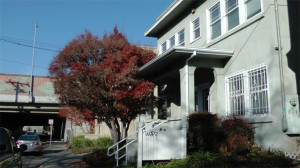The shifting landscape of Bay Area real estate sometimes offers unexpected opportunities for artists to create new work during periods of transition, particularly in spaces on the verge of total redevelopment. Over dinner one night, friends of artists Ernest Jolly and Chris Evans talked about their recent purchase of a former dental office in Oakland’s Northgate neighborhood, and revealed that the waiting period for permits would leave the space empty and idle for three months. Jolly and Evans recognized an interesting exhibition opportunity, and — with the owner’s permission and little else in terms of support — acted quickly, inviting six artists, who in turn invited six more to participate in ArtComplex, a pop-up exhibition that includes performances and installations.
There is something oddly compelling about gaining access to the spaces of a doctor’s office that might formerly have been off limits — at the same time, the reimagining of familiar spaces has another appeal. Modesto Covarrubias’ ongoing installation The Waiting Room occupies the former waiting room. Visitors are invited to take up massive wood knitting needles, as thick as broom handles, and contribute to the artist’s continually evolving soft sculpture. The off-white contours of the growing mound of knitted yarn fill the room, encouraging a return visit to the show. Certainly the installation will look very different in a few weeks’ time. The work elegantly channels the former functions of the waiting room through its time-based evolution, patiently and steadfastly contributed to by the people who pass through. How many people, one wonders, passed time knitting in this room? Still, the act of waiting is a transitory state and in this regard, the work also reflects the status of the building and indeed the city in its transformation.

Other works address history more specifically. On the second floor, Karen Seneferu’s installations occupy a space that might have been an office. Among the several works installed, including a wall-based light sculpture and an iPhone video housed in a found statue, Seneferu’s short video loop Fruitvale to Florida: Strange Fruit No More offers silent video portraits of individuals standing at various sites that speak to violent histories, overlaid in some instances with vintage still photographs of “ancestors.” One still depicts Cephus Johnson, uncle of the late Oscar Grant and Executive Director of the Oscar Grant Foundation, standing on the platform of the Fruitvale BART station where Grant was shot and killed by BART police officer Johannes Mehserle on New Year’s Day 2009. The title loops the recent killing of Florida teen Trayvon Martin into a consideration of the work, even in the absence of direct images. The unwavering gaze of Seneferu’s largely African-American subjects, many of whom were strangers approached impromptu by the artist, paired with archival stills, speaks volumes even without dialogue, about Oakland’s historically significant role in the national dialogue about equality, racism, and violence.
Down the hall, an incredibly subtle installation by Amy M. Ho simultaneously interrogates presence and absence. Ho’s video installation, titled The Light from Yesterday occupies a corner skylight in an otherwise empty examination room, save for a long wooden bench. It projects a twenty-four hour period of shifting ambient light compressed to a ten-minute loop. Upon entry one’s eyes take time to adjust to the velvet blackness of the darkened room; within a few moments, the light shifts imperceptibly and the space and the silhouettes of other viewers become visible. By capturing the gradations of changing light in the room, Ho’s work reveals something about the seemingly unremarkable moments in every day life and the relatively dramatic changes that occur over extended periods of time.

As one exits the historic building that houses ArtComplex — originally residential, the building dates from 1900 — one sees a spectrum of urban renewal on the street. One end is enshrouded in the shadows of a massive freeway overpass, signifying the changing needs of the city, while the Victorian Carpenter Gothic style building of St. Augustine’s Episcopal Church circa 1892 occupies the other end. The church also embodies radical change: In 1910 it was established as a centralized place of worship for African American Episcopalians who were otherwise scattered in largely white churches around the Bay Area. In the 1960s it was a primary meeting place for the Black Panther Party — in 1969, St. Augustine’s was host to the Black Panther Party’s Free Breakfast Program for School Children, organized by Ruth Beckford. In light of these select histories, St. Augustine’s signifies the ever-shifting landscape of Oakland’s history.


